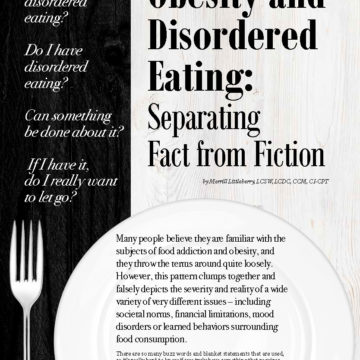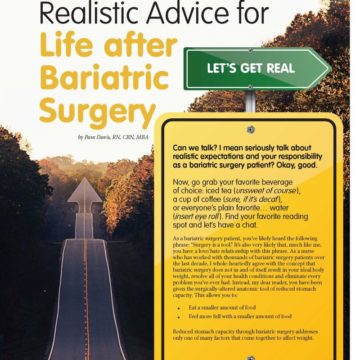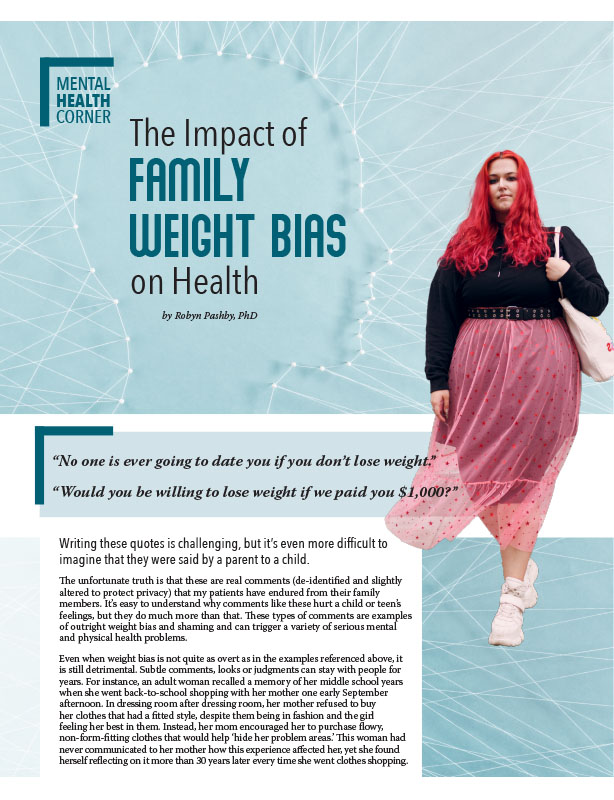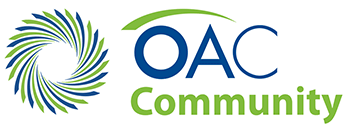Reset for Success with Therapeutic Movement

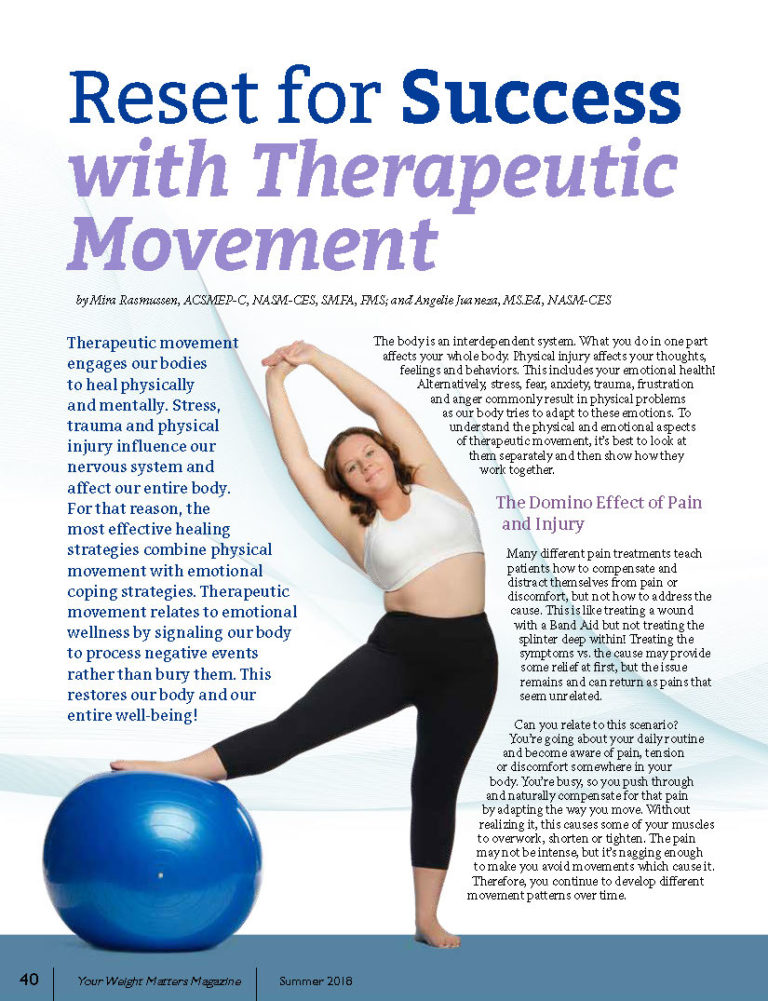
by Mira Rasmussen, ACSMEP-C, NASM-CES, SMFA, FMS; and Angelie Juaneza, MS.Ed., NASM-CES
Summer 2018
Therapeutic movement engages our bodies to heal physically and mentally. Stress, trauma and physical injury influence our nervous system and affect our entire body. For that reason, the most effective healing strategies combine physical movement with emotional coping strategies. Therapeutic movement relates to emotional wellness by signaling our body to process negative events rather than bury them. This restores our body and our entire well-being!
The body is an interdependent system. What you do in one part affects your whole body. Physical injury affects your thoughts, feelings and behaviors. This includes your emotional health! Alternatively, stress, fear, anxiety, trauma, frustration and anger commonly result in physical problems as our body tries to adapt to these emotions. To understand the physical and emotional aspects of therapeutic movement, it’s best to look at them separately and then show how they work together.
The Domino Effect of Pain and Injury
Many different pain treatments teach patients how to compensate and distract themselves from pain or discomfort, but not how to address the cause. This is like treating a wound with a Band Aid but not treating the splinter deep within! Treating the symptoms vs. the cause may provide some relief at first, but the issue remains and can return as pains that seem unrelated.
Can you relate to this scenario? You’re going about your daily routine and become aware of pain, tension or discomfort somewhere in your body. You’re busy, so you push through and naturally compensate for that pain by adapting the way you move. Without realizing it, this causes some of your muscles to overwork, shorten or tighten. The pain may not be intense, but it’s nagging enough to make you avoid movements which cause it. Therefore, you continue to develop different movement patterns over time.
These changed patterns happened little by little, so each progression feels normal. However, they affect joint alignment and the function of your muscles. Fast forward to a day where a seemingly simple movement requires a joint or muscle to work in full function, but it can’t because the limits you’ve set for months or years have caused injury. This is the moment when demand on the body is greater than it can give due to the joint’s range of motion or the stability of the supporting tissue. Progressing pain or injury can start with simple shoulder tension that slowly impacts your mobility in the mid-back and then your shoulders – eventually misaligning the shoulder joint and resulting in a much more serious injury like the one mentioned in the diagram below.
Changing Our Perception
In our modern, Western society, we tend to sit too much – at our desks, in front of the television and in our cars. Too much sitting shortens the muscles in front of our body and extends the muscles in the back of our body. Our hips often become restricted by tightness in other parts of the body. Our shoulders can be restricted by tightness in our chest, shoulders, biceps and neck.
Do these areas of pain sound familiar? What if you knew these areas of tightness usually start problematic movement patterns which result in knee, ankle, feet, neck and back issues? When certain places in our body hurt or ache, it’s natural to think the cause is located where it hurts. However, it’s more productive to address the true cause of pain and accept that it may not be where we think it is.
Therapeutic Movement – The Physical Approach:
Treating movement problems that cause pain or injury completely changes the way forward-thinking healthcare professionals work with injury and pain. The biggest predictor of injury is previous injury.
A preventative approach to injury stops movement problems in their tracks – just like monitoring blood pressure for heart health or preventing cavities with regular teeth cleanings. The most beneficial approach to any exercise program is one that uses corrective exercise as its foundation. Doing this on your own requires slow and progressive steps that allow you to work through pain and strain rather than ignoring them. Try to understand which muscles you need to work rather than simply mimicking how another person moves.
For example, many people feel strain in their arms when exercising their back. This is because they are actually using the muscles in their arms instead of the muscles in their back. When you use the correct muscle to perform a specific movement, you reach success sooner with little to no pain. Muscles should burn, but joints shouldn’t hurt. Corrective exercise drives the right kind of movement and resets the body to perform daily tasks easier than before!
Corrective exercise takes time. During this time, your mind and body work together as a team to build a solid foundation. If you were to participate in HIIT (High Intensity Interval Training) before your mind and body were prepared, it would hurt more than it can help! This wouldn’t help your fitness level. HIIT is beneficial as most workouts tend to last anywhere between 10-15 minutes, whereas traditional workouts typically last an hour. This type of training has its time and place, depending on your physical and emotional experience. If you do not have experience with high-intensity exercise such as HIIT, you could risk muscle and joint problems instead of reaping the benefits.
Before you begin an exercise, take time to evaluate its physical and emotional demands. You should push yourself physically to reach a stronger sense of accomplishment with the challenges you take on. This happens layer by layer – not all at once.
Therapeutic Movement – The Emotional Approach:
A healthy emotional foundation is essential to corrective exercise and therapeutic movement. It can help you recover in a variety of ways!
Fear, anxiety, frustration, sadness and anger tell muscles to round the shoulder, push the head forward and down and draw the knees in from the hips. This is our body’s most protective position. However, it does not give our bodies the chance to release these tense muscles, so they become tightly clenched. This creates both muscle and emotional tension.
Think about actions such as clenching your fist when you’re angry or grinding your jaw when you’re stressed. This emotional/physical response can start from one single negative experience or multiple small ones. Our body reacts to the environment we put it in. If you
want to move and perform successfully, take the time to create a supportive environment. It’s a large portion of your success!
Create the Optimal Emotional Environment
A private atmosphere such as a training studio can offer individualized focus for both you and the health and wellness professional! More private, client-focused locations tend to be free of pressure and competition. This lets your body connect with your mind in a way it hasn’t necessarily done before.
When you move, most of the work you do is through coordination and cues from your nervous system. If your nervous system is emotionally clouded, your ability to exercise will be too. Nerves tell your body how, when and with what force to respond. In therapeutic movement, the body needs to be free from distractions so it can focus on a new way of programming. Your goal should be to move well in an environment that gives you focus and then move well in an environment you feel motivated in. Take time to discover what facilities near you offer for restorative exercise and determine what factors will meet your emotional needs so you can focus on movement.
We can’t deny our emotional needs, even in a workout. If we do, we will develop negative coping strategies that affect our goals. For example, when we chronically tense our bodies into a fetal position, it negatively affects our physical progress.
When we are faced with situations in which we’ve experienced failure before, subconscious coping strategies may develop to avoid those experiences. If
you have tried movement in a gym before, new plans for the gym may lose
their priority if an opportunity arises to replace that time with something else that’s positive.
When faced with previous failures, consider the emotions which reinforce those failures and then re-structure your next workout to be positive, even if it’s short. You can build from small successes. Other coping mechanisms go much deeper as they are involved with emotional trauma. Finding a health professional to work with can help you heal emotionally and open your body
to movement.
As your mind builds mental confidence, your body builds confidence in movement. When you exercise in a way that decreases pain and discomfort, your joints, tendons, ligaments and muscles will work together as a team. Start by learning how the body should move without compensations. You will create a solid foundation for greater successes later in your health and fitness journey. With increased strength and balance in each small movement, you can achieve higher levels of fitness and find greater success with weight management.
Conclusion
Our emotional and physical selves are more deeply connected than we assume. They must work as a team to create overall well-being. When we allow this to happen during movement and exercise, we tend to find bursts of motivation, physical ability and productivity. Combined, this leads to a life of success in your fitness journey!
About the Authors:
Mira Rasmussen, ACSM EP-C, NASM-CES, SMFA, FMS, is an exercise physiologist and founder of Fitness Beyond Training studios in central Texas. Her passion is helping people redefine exercise so they thrive in it rather than suffer from it. She specializes in functional and corrective exercise as a foundation for athletic performance, general fitness and weight management. Using these methods, everyone can overcome their weakness and achieve
their goals. To learn more about Fitness Beyond Training, visit
www.fitnessbeyondtraining.com.
Angelie Juaneza, MS.Ed., NASM-CES, earned her Masters of Science in Exercise Physiology from the University of Mary Hardin-Baylor in Texas. She is an Exercise Physiologist and Health Fitness Professional with a Corrective Exercise Specialist certification. Angelie specializes in functional training for the general population, athletes, those handling diseases or any other physical limitations. She has a background in exercise testing and supplement research studies which has fueled her passion for educating others through their health and fitness journey. For more information on the author, visit: www.fitnessbeyondtraining.com.
by Yelena Kibasova Spring 2024 The fitness world is evolving, with new trends and innovations that promise…
Read Articleby Kendall Griffey, OAC Communications Manager Spring 2024 We have officially kicked off Your Weight Matters Regional…
Read Articleby Robyn Pashby, PhD Winter 2024 “No one is ever going to date you if you don’t…
Read Article




